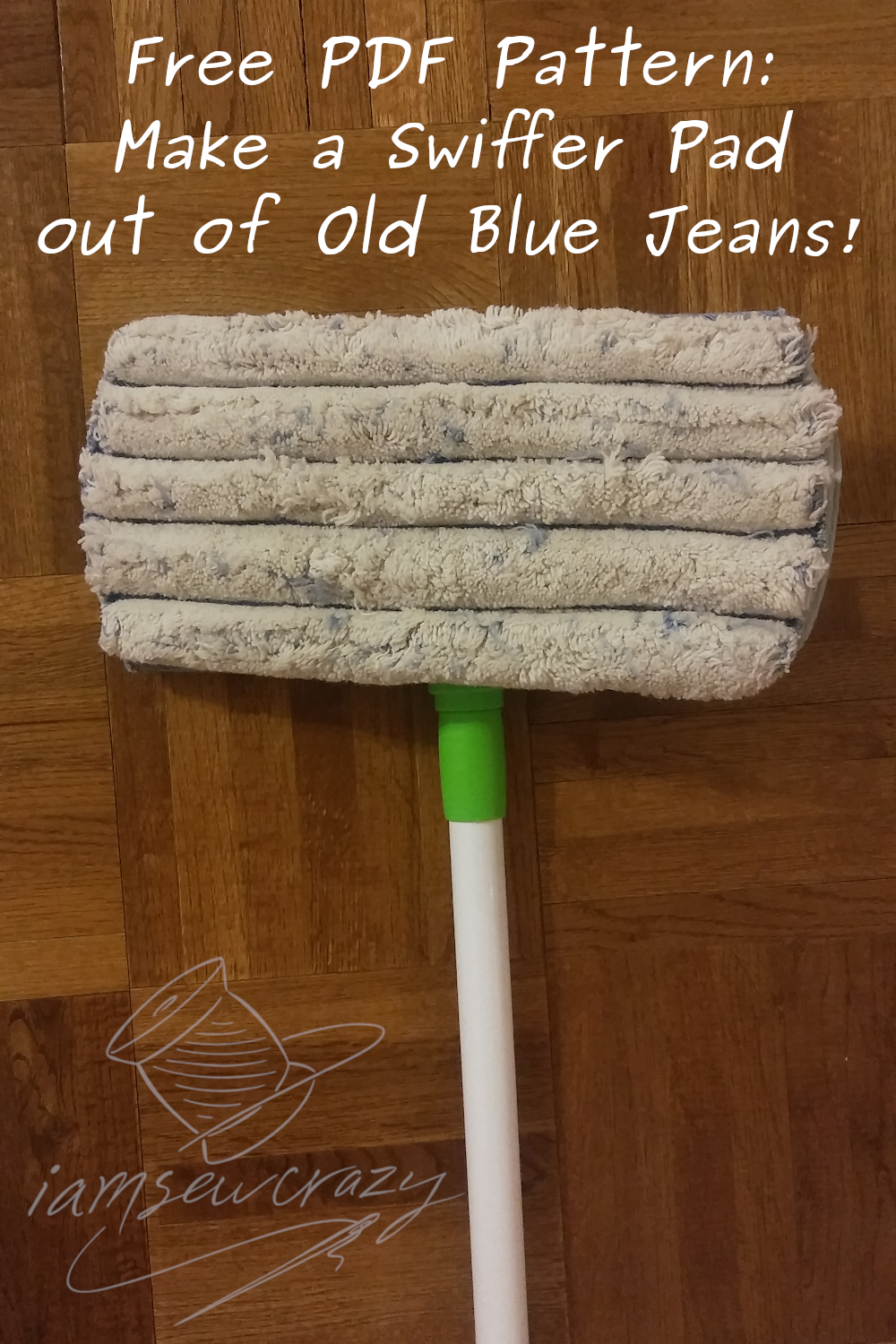
Let me show you how to make a Swiffer®* pad out of upcycled blue jeans! It’s reusable, machine-washable, eco-friendly, recycled, fast to make, fuzzy, and absorbent. To top it all off, I’ve provided a FREE printable PDF sewing pattern, so that it’s super easy to make your own Swiffer® pad!
I can cut and sew a Swiffer® pad in less than 30 minutes. My method uses a crazy-fun sewing technique to make a thick, fuzzy mop pad, with very little actual sewing. The layers of denim form a soft, absorbent textured chenille surface, which is also a great technique to make fuzzy bath mats and dusting mitts.
Since you can wash and reuse the mop pad, you won’t be adding another disposable dusting or mopping pad to the landfill every time you clean. And because it’s made with denim (which is made from cotton), it’s also biodegradable! The mop pads also get even better and softer as you wash and re-use them, so there’s a lot to love about this sewing project!
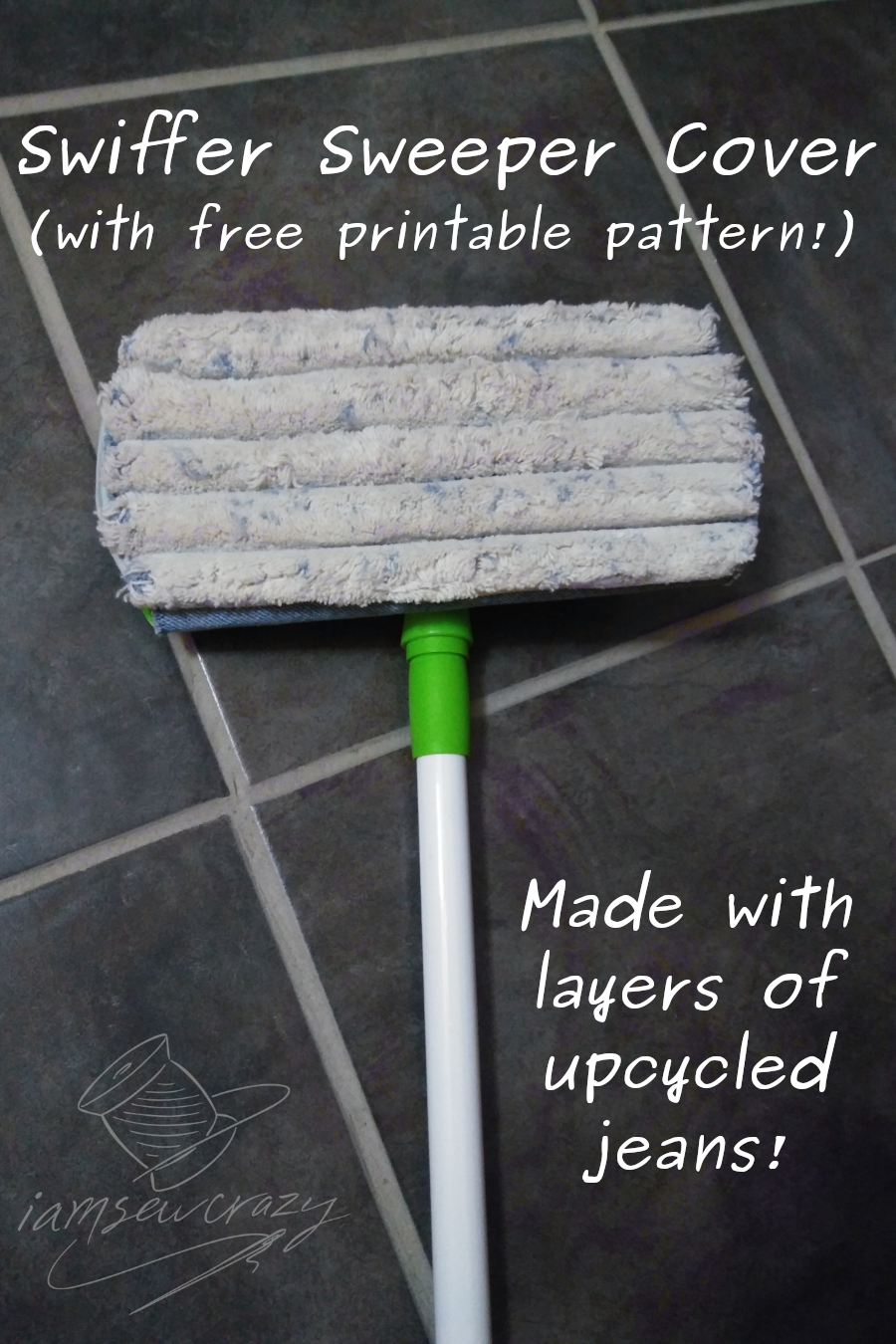
I use two other secret weapons to keep my floors clean: my robot vacuum, which is one of my favorite things. And this Better Life plant-based floor cleaner (you might have seen it on Shark Tank). I’ll give you a rundown of my cleaning techniques at the end of the post (including how to make dryer static work FOR you)! But first, here’s how to make your own reusable Swiffer® pad.
By the way, this is one project that would be very difficult to hand-sew. So if you don’t have a sewing machine, you can always buy reusable Swiffer® pads on Amazon, which will still save landfill waste and money over time.
(*This DIY reusable mop pad is not endorsed by or affiliated with Swiffer® Sweeper®, or the Proctor & Gamble Company. Swiffer® Sweeper® are registered trademarks of the Proctor & Gamble Company.)
Step 1: Print the Sewing Pattern
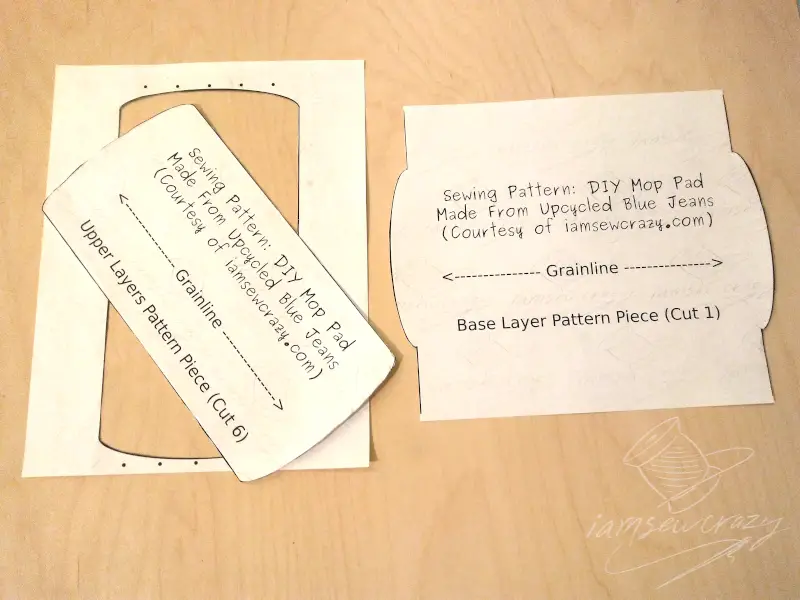
The first thing you need to do is print the PDF sewing pattern that I’ve made for you.
Save the outer oval piece with the dots on it; you will need it later!


Print the pattern at 100% (no scaling), cut the base piece out, and check to see how it fits your mop by wrapping it around the mop head, like the picture above shows. If it fits your mop, then great! You can get right to cutting and sewing!



If the pattern doesn’t fit, that’s okay! Just take a minute to trace your mop head like I’m doing in the pictures. This will be the pattern you’ll use for the chenille layers. Then trace it again, and draw the “wings” that will fold around and fasten into the holding clips on top of the mop head. This will be the pattern for your base layer. You can see the shape of the two pattern pieces in the last picture above; my “wings” ended up being 2″ wide. If your particular mop doesn’t have clips to hold the pad tight, you can add straps that will wrap around the top of the mop head and fasten together with velcro.
Step 2: Cut the Jeans

Now that you have your pattern, you need an old pair of 100% cotton blue jeans. This pair of jeans is cut to bits because I’ve already used it to demonstrate How to Reuse a Jeans Button, and for my tutorial about Seven Easy Ways to Make a Waistband Bigger. I also used it as backing material to patch a pair of blue jeans, and one whole leg is missing but I can’t remember what I made out of it, lol. Anyway, I only have half of the jeans left, but that’s plenty of fabric to make a Swiffer® pad. In fact, any pair of adult jeans should yield at least two complete mop pads. I do not recommend buying new denim fabric for this project, for two major reasons: because new denim can leach dye, which is definitely not what you want in a cleaning cloth. And because worn-out jeans are so easy to find and upcycle into something useful, instead of just throwing them away!


Now, we need to cut out the pattern pieces. Cut the base layer first, because it’s the largest piece, and therefore the most difficult to fit on your jeans. You will probably need to cut it out of the thigh area, just under the pocket. You want to avoid existing seams, rivets, and other scratchy parts. Once you have the base cut out, it will be easier to fit the smaller layers on the remainder of the jeans. I usually use a rotary cutter and cut through both sides of the leg at once. But I use scissors if the jeans have tears, embroidery, or other areas on one side that I want to avoid.
The arrows that say “grainline” are supposed to be lined up perpendicular to the waistband. Cut one base layer, and six upper layers.
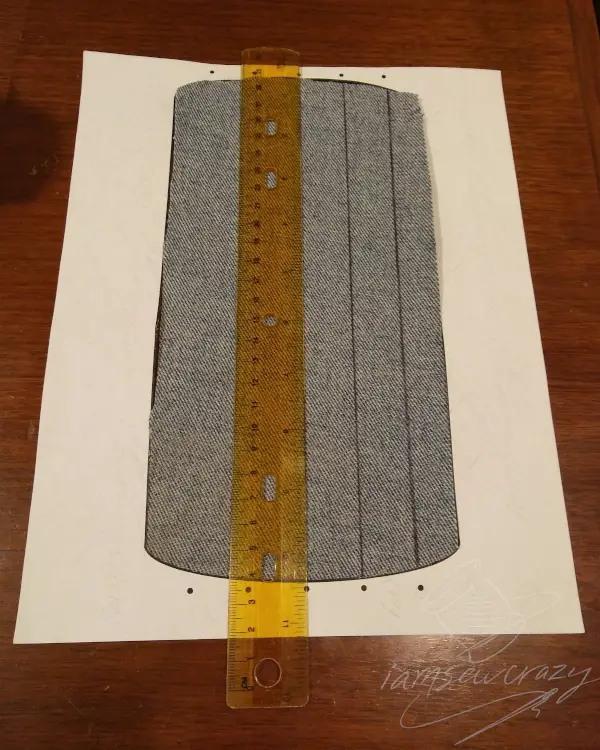
Take one of the upper layers of fabric, and place it into the paper cutout from the pattern that I told you to save. (You remembered, right?) Use the dots on the paper to mark stitching lines by lining up a ruler from dot to dot, and drawing lines to connect the dots.
Step 3: Sew the Swiffer® Pad
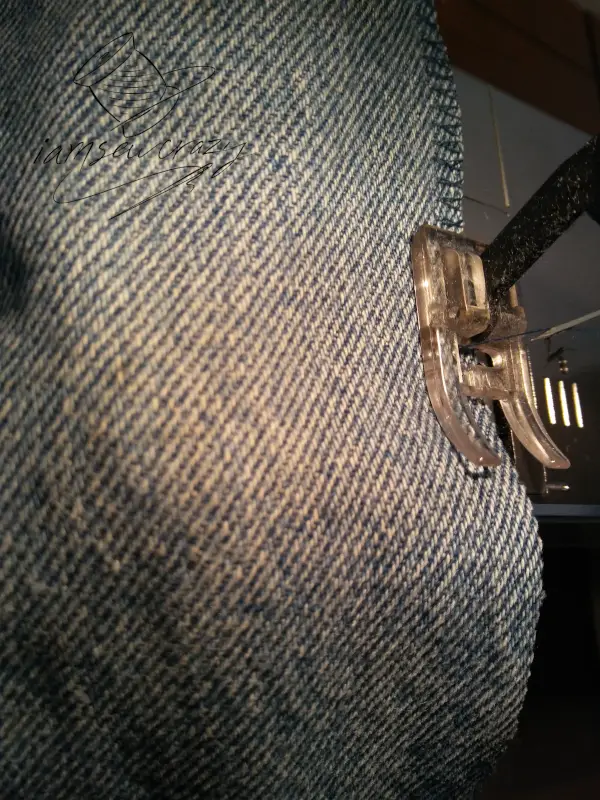
Take the base layer and sew with a wide zigzag around the entire edge. Align the fabric so that the needle sews into the denim when it zigs, and just misses the fabric when it zags.
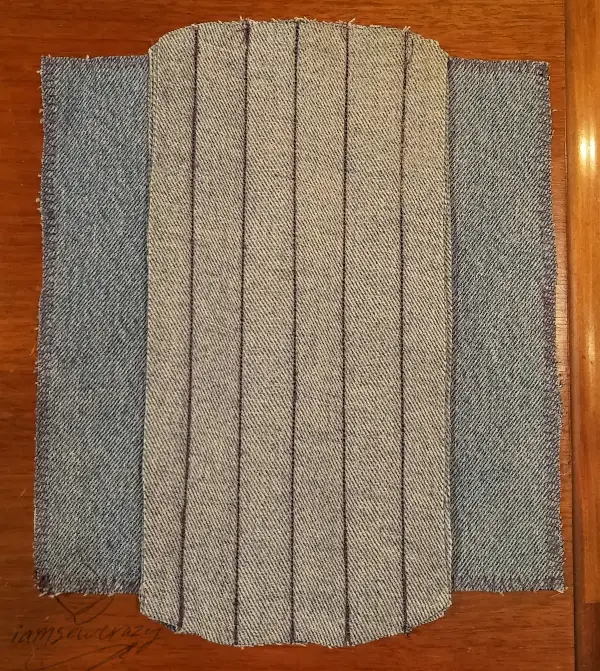
Stack up all the layers, with the large base piece on the bottom, and the piece with the lines on top.

Sew along each marked line to join all of the layers together. This reusable Swiffer® pad is a zero-waste project, and it’s not meant for a fashion runway. So you can use random bits of different-colored thread that you have left over from other projects. You will see that the back of this mop pad looks like a rainbow, because I used 5 different almost-empty bobbins to sew it!
How to Sew Through Thick Layers of Fabric

The DIY Swiffer® pad we have been making in this post is made from seven layers of denim. If you own a light-duty sewing machine, such as a travel-size machine, it simply may not be able to accommodate that much material. My vintage machines have no trouble with even eight layers, but if you try all of these tips and your machine truly can’t handle that thickness, then you can reduce the number of upper layers that you use. Even 3 layers of fuzzy chenille will still make a very nice mop pad! Here are some tips to set yourself up for success when you are sewing through many layers of fabric:
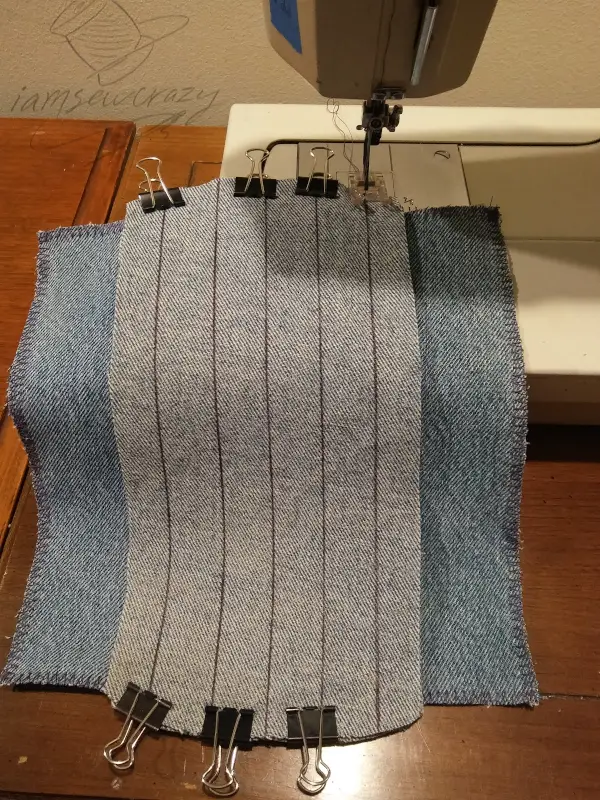
Use binder clips, clothespins, or quilting clips to hold the layers together. (You can forget about pinning through something this thick!)
When you are sewing through multiple layers, it’s a good idea to reduce the pressure on your presser foot. Most sewing machines do have this option, but you might not be very familiar with it because you don’t usually need to adjust it.
Some machines have a dial on the outside, close to the presser foot lever. Some have a post on the top of the machine. And some have a dial inside the cover, near the thread take-up lever. Take note of the settings before you make any changes, so that you can return the presser foot pressure to its previous setting when you are done sewing your Swiffer® pad.


If your machine has a dial, set it to a low number.
If your machine has a post that goes in and out, press on the metal ring at the base of the post to make the post pop out. To sew through all of these layers, the post should be sticking mostly out of the machine. Push down on the post to increase the foot pressure when you are through sewing your mop pad.
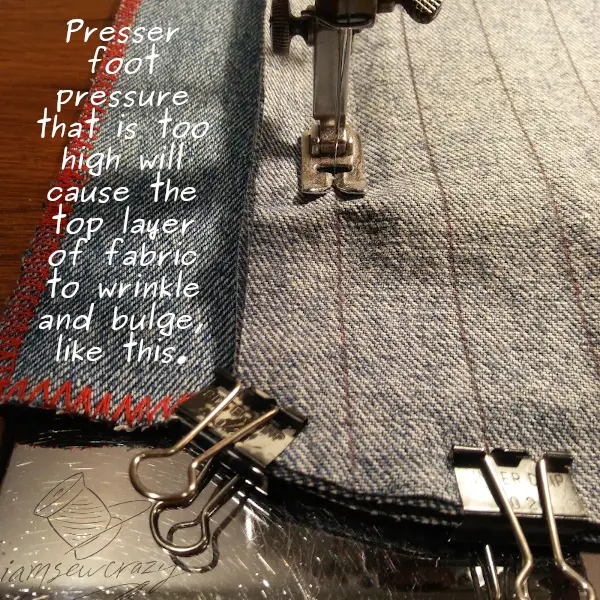
If your presser foot pressure is too high, the top layer of fabric will be bubbling and wrinkling as the excess pressure keeps it from feeding smoothly, and stretches it out of shape.
You can sew a test scrap to see if you’re happy with the settings before you begin sewing. If you experience wrinkling like in the picture above, try adjusting your machine’s foot pressure again.
Be aware that you may need to lower your thread tension as well.
Make sure to use a jeans needle (it may be called size 100 regular or size 16 sharp, depending on where you live). Install a new needle for this project to make sure that you aren’t trying to go through all of those layers with an old, dull needle.
I’m using a triple stitch (your sewing machine might call it a straight stretch stitch) where each stitch is 3 mm long (roughly 8 stitches per inch). This is a stitch that takes two stitches forward, and one stitch backwards. It’s a very sturdy, self-locking stitch that will hold all of the fuzzy denim fringe in place through repeated washings and re-usings of the mop pad.
Your stitch length matters a lot when you sew multiple layers of fabric. If you shorten it too much, you will notice the thread or needle breaking, the machine stalling or making thumping sounds, and problems with the fabric feeding. If you are noticing any of the problems I mentioned, try increasing your stitch length.
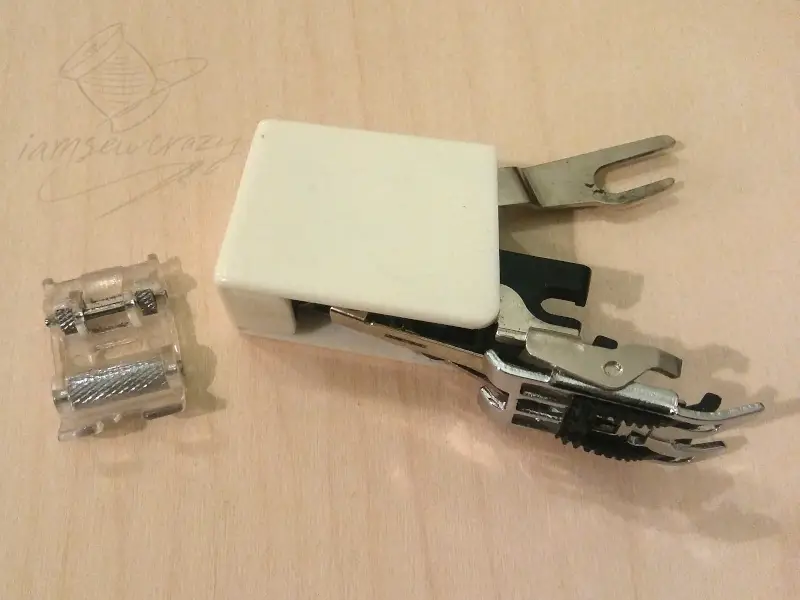
If you have a roller foot or a walking foot, then this is the perfect time to use it. A roller foot (left) has rollers on the bottom, like little wheels. The rollers let the fabric move under the foot without exerting much friction. And a walking foot (right) actually has its own set of feed dogs that use the motion of the needle bar to feed the fabric from the top, while the normal feed dogs feed it from underneath. Either foot is going to give you an advantage when you’re sewing through something that’s heavily textured or thick, like the denim we are using here.
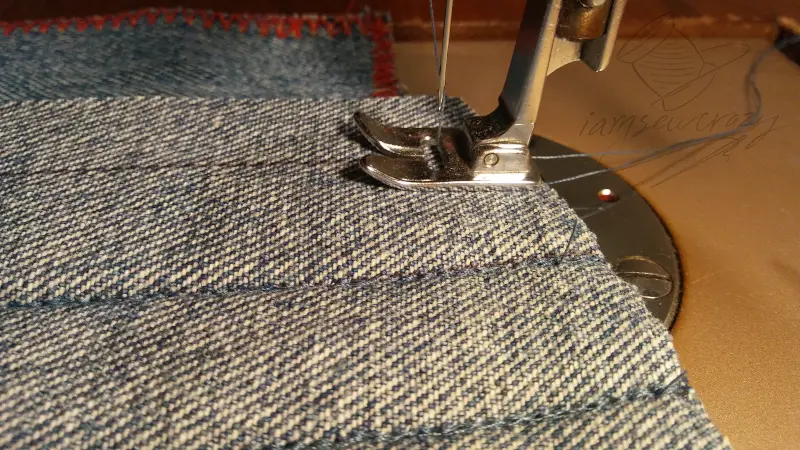
I always prefer to start sewing about half an inch (a centimeter or so) from the edge. I sew backwards until I get to the edge, and then go forwards to complete the seam. This helps keep the thread tails from snagging.
When the layers of fabric are super bulky, your presser foot can get tilted when you are near the edge of your project. You can use a folded scrap of fabric or a hump jumper to level the presser foot, if you need to. Fold the scrap so that it’s the same thickness as your project, and place it behind your work so that the needle is at the edge of the mop pad, and the back of the presser foot is resting on the fabric scrap or hump jumper. This will help you get started without having the presser foot tilted at a funky angle.
My last tip is to make sure that you’ve lowered your presser foot before you start sewing! Sometimes a thick material can trick you into thinking you’ve lowered the presser foot when you haven’t, because the foot is already touching. But you have to make sure that the presser foot lever is down, because if it isn’t, you won’t have any tension on your needle thread.
Now you’re all set to sew through a bunch of layers! Sew on the five marked lines through all of the denim layers, from one end of the mop pad to the other. For this particular project, you’ll want to sew one line, then flip the mop pad around and sew the next line. Don’t start at the same end for all of the lines, or else you’ll magnify any shifting that the layers might have done.
Step 4: Cut the Layers into Fringe
I’m using a chenille cutter to cut the fringe after I’ve sewn the layers. A chenille cutter (also called a slash cutter) is sort of like a rotary cutter, but it doesn’t cut all the way through. It has a guide on the bottom that lets you cut through the top layers to form the fringe that makes this mop pad clean so well, but it leaves the bottom layer intact. A chenille cutter isn’t essential; you can use scissors instead. But I already own a chenille cutter that I use in some of my other work, and it does save a crazy amount of time and hand fatigue from making a billion snips with scissors. If you need more than a couple of mop pads, or if you’re going to be selling them or making them for gifts, you will probably want to get a chenille cutter. And as I mentioned at the beginning of the post, this layered chenille technique is also a great way to make dusting cloths, bath mats, and even cozy blankets and throw pillows.
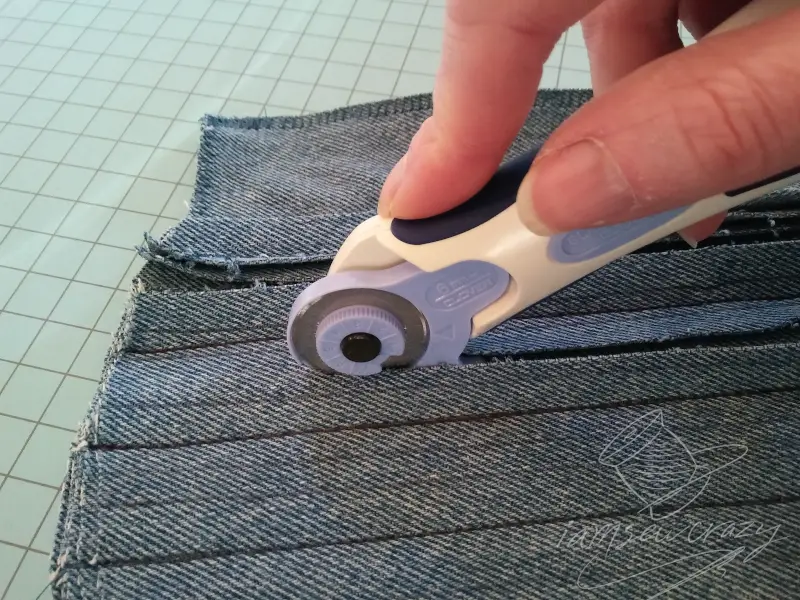
Take your chenille cutter and slide the guide between two rows of stitching. You might find that it’s easiest to cut one layer at a time, or you can try multiples. When your cutter gets dull, you can advance the blade to a new, sharp section. (I show you how to do this in the video.)
If you’re using scissors, you’ll have to make fairly short snips in order to fit your scissor blades in between the stitches. Cut all of the upper layers, but leave the base layer intact.
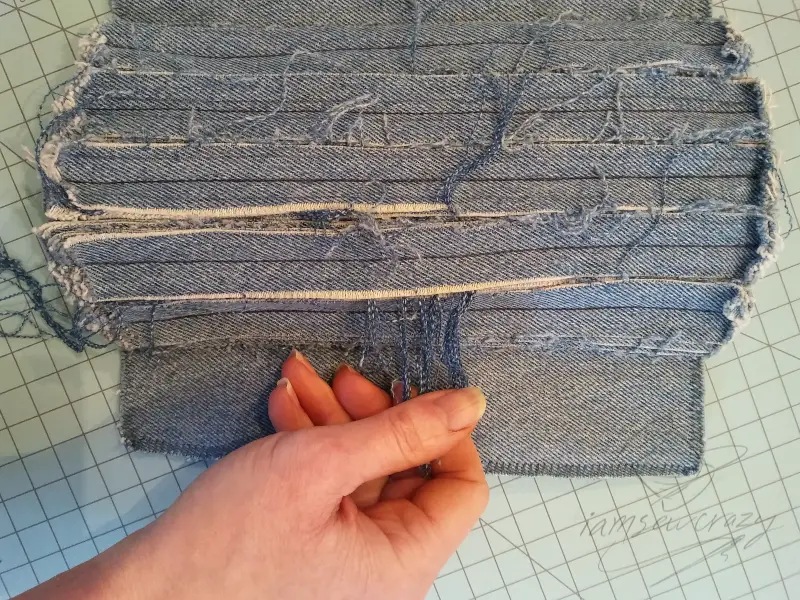
Here comes the fun part… turn the cut fabric edges into fringe! Fray the layers of your mop pad by pulling out the long blue threads. You can do it in front of the TV, using a seam ripper to help. Or bribe the kids to do it for you! Honestly it can be kind of fun to fidget the fabric apart. You’ll be pulling out the blue threads and leaving the white ones.

Cut off any long threads that are still hanging on, so that your mop pad looks like the one in the picture.

And this is what the mop pad looks like after just one trip through the washer and dryer! It becomes three times thicker as the fringe blooms into rows of fuzzy, absorbent, recycled cotton chenille.
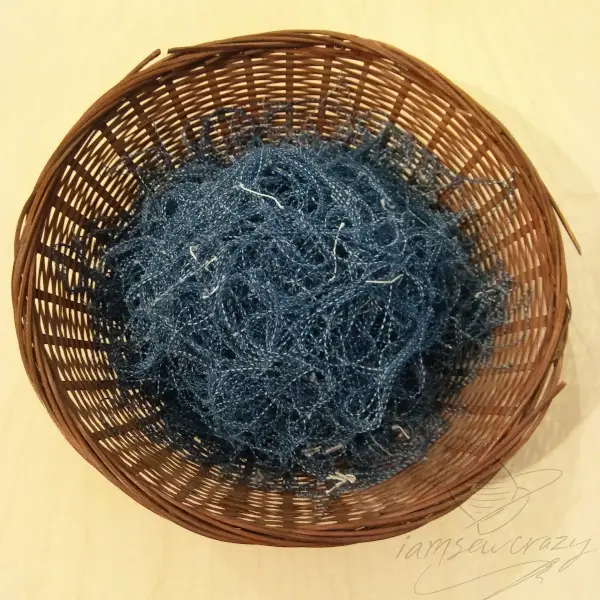
You’ll be left with a pile of threads to throw away, or maybe fill a stuffed toy with!
How to Use Your DIY Swiffer® Pads
You always need to vacuum before you mop, and my favorite way to vacuum is to have someone (or something!) else do it for me. When I got this robot vacuum, I felt the same as I did when I got a dishwasher: What took me so long?! I named my vacuum Elrod, and I love how well he keeps the floors clean. He navigates with a laser, so he’s very methodical in how he cleans, instead of ping-ponging around the house. It’s so nice to come home to vacuumed floors without having to lift a finger. Elrod is a Neato D4, which is an older model, but there are some robot vacuums out nowadays that can empty themselves, and even some that mop as well as vacuum! I still use and love my Shark DuoClean upright vacuum when I vacuum the staircases, the above-floor surfaces, the inside of the vehicles, etc.

As I mentioned at the beginning of the tutorial, I have tested this DIY mop pad and eco-friendly floor cleaner on many flooring types. I have hardwood in the living room, master bedroom, sewing room, and a beautiful hardwood parquet in the hall. There’s tile in the kitchen, upstairs bathroom, and my mermaid master bathroom. Two bedrooms and the pantry have vinyl plank flooring, and the laundry room and guest bath both have vintage linoleum! So this DIY mop pad has seen use on lots of different flooring types, and I like using it both dry (as a dust mop) and wet (to clean up messes and splatters).
In the past, I used vinegar and water to clean my tile floors, but I have since learned that acids can be very damaging to grout and chipped or scratched tiles. I tried a few other cleaners, but my favorite by far has been this Better Life Naturally Dirt-Destroying cleaner that was featured on Shark Tank. I love the smell, and I can use it on all of my different floor types. A little goes a long way, and I like the fact that I don’t need to air the house out when I’m done cleaning!

If you are wet-mopping, you will want to vacuum the floor first. (Or have a robot do it for you!) Start with a damp mop pad, and squirt a little of the Better Life cleaner on the floor. A little goes a long way! If you are cleaning a hardwood floor, try to wipe with the grain of the wood (although wiping with the grain is pretty much impossible with a parquet floor like this one). Rinse or change the mop pad when it gets dirty, or else eventually you’ll just be spreading the dirt around.
If you are dry-mopping, you can just grab a mop pad and go to town. My bedroom area is a small loft above the sewing room, and it really only needs a good dusting every once in a while. I start with the top of the dresser and nightstand, while the mop pad is still clean, and then move on to the floor.
How to Wash the Swiffer® Pads
So now you have clean floors, and a dirty mop pad. How do you wash and reuse it? I set the dirty mop pads and other cleaning rags aside in a wire basket in my laundry room, until I have a good-sized load. Then I wash them all together on the heavy-duty cycle of my washing machine, in hot water. I use Tide Original detergent, and add about 1/4 cup of washing soda to the load. (I have hard water in my area, so the washing soda helps a lot, but your local water might be different.) I fill the fabric softener compartment with white vinegar, so that it gets dispensed into the rinse water. Don’t use any fabric softener or dryer sheets when you wash rags and mop pads, because this will make them less absorbent, and it will work against the electrostatic charge that helps them hold on to dust so well.
Next, all of the rags and mop pads go into the dryer. (Again, no softener or dryer sheets!) I over-dry them on purpose, to give the dusting pads an electrostatic charge. This really works! The static causes the pads to grab on to dirt and hair when I’m using them for cleaning. The static does not help when you are using the pads for wet mopping, because moisture removes the static charge. But I never know how many I’ll use for wet mopping vs dry when I wash them, so they all get over-dried and charged up with static. Make sure that you store them in a dry area, since moisture and humidity will decrease the static charge. If your house is humid, you may choose to run them through the dryer again right before you use them.
After I wash a load of rags, bath mats, or my cat Patches’ beds, I run the washing machine’s self-clean cycle. My washer’s manual says to run this cycle once a month, and that’s about how often I need to wash rags or kitty beds. So it works out pretty well for me, and the washer is clean and fresh, ready for the next time I need to do laundry.
If you ever have to clean up anything excessively oily or flammable, like gasoline, then the rags should be properly disposed of, and should NOT go into the washing machine. Use an old t-shirt or scraps from your sewing instead of your nice mop pads, because trying to wash and dry a mop pad with lots of oil or gasoline on it is a fire hazard, and it’s not good for the machines or the plumbing.

Now you know how to make a Swiffer® pad! I hope you enjoyed the tutorial and sewing pattern. Feel free to share this article, or pin this idea to save it for later!


Awesome idea. Now I have another use for old jeans. Thanks.
I’m glad you liked it!
I don’t sew but posts like this make me wish I did. It looks so satisfying!
It’s a really great hobby! And it’s never too late to start 😁